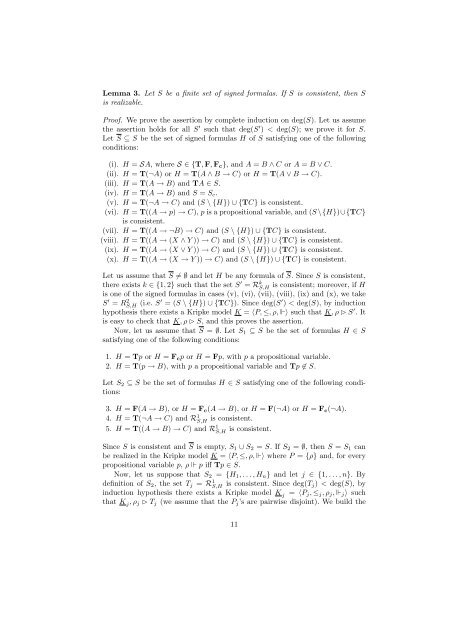A refined calculus for Intuitionistic Propositional Logic - DISCo
A refined calculus for Intuitionistic Propositional Logic - DISCo
A refined calculus for Intuitionistic Propositional Logic - DISCo
Create successful ePaper yourself
Turn your PDF publications into a flip-book with our unique Google optimized e-Paper software.
Lemma 3. Let S be a finite set of signed <strong>for</strong>mulas. If S is consistent, then Sis realizable.Proof. We prove the assertion by complete induction on deg(S). Let us assumethe assertion holds <strong>for</strong> all S ′ such that deg(S ′ ) < deg(S); we prove it <strong>for</strong> S.Let S ⊆ S be the set of signed <strong>for</strong>mulas H of S satisfying one of the followingconditions:(i). H = SA, where S ∈ {T, F, F c }, and A = B ∧ C or A = B ∨ C.(ii). H = T(¬A) or H = T(A ∧ B → C) or H = T(A ∨ B → C).(iii). H = T(A → B) and TA ∈ S.(iv). H = T(A → B) and S = S c .(v). H = T(¬A → C) and (S \ {H}) ∪ {TC} is consistent.(vi). H = T((A → p) → C), p is a propositional variable, and (S \{H})∪{TC}is consistent.(vii). H = T((A → ¬B) → C) and (S \ {H}) ∪ {TC} is consistent.(viii). H = T((A → (X ∧ Y )) → C) and (S \ {H}) ∪ {TC} is consistent.(ix). H = T((A → (X ∨ Y )) → C) and (S \ {H}) ∪ {TC} is consistent.(x). H = T((A → (X → Y )) → C) and (S \ {H}) ∪ {TC} is consistent.Let us assume that S ≠ ∅ and let H be any <strong>for</strong>mula of S. Since S is consistent,there exists k ∈ {1, 2} such that the set S ′ = R k S,H is consistent; moreover, if His one of the signed <strong>for</strong>mulas in cases (v), (vi), (vii), (viii), (ix) and (x), we takeS ′ = RS,H 2 (i.e. S′ = (S \ {H}) ∪ {TC}). Since deg(S ′ ) < deg(S), by inductionhypothesis there exists a Kripke model K = 〈P, ≤, ρ, ⊩〉 such that K, ρ ✄ S ′ . Itis easy to check that K, ρ ✄ S, and this proves the assertion.Now, let us assume that S = ∅. Let S 1 ⊆ S be the set of <strong>for</strong>mulas H ∈ Ssatisfying one of the following conditions:1. H = Tp or H = F c p or H = Fp, with p a propositional variable.2. H = T(p → B), with p a propositional variable and Tp ∉ S.Let S 2 ⊆ S be the set of <strong>for</strong>mulas H ∈ S satisfying one of the following conditions:3. H = F(A → B), or H = F c (A → B), or H = F(¬A) or H = F c (¬A).4. H = T(¬A → C) and R 1 S,H is consistent.5. H = T((A → B) → C) and R 1 S,H is consistent.Since S is consistent and S is empty, S 1 ∪ S 2 = S. If S 2 = ∅, then S = S 1 canbe realized in the Kripke model K = 〈P, ≤, ρ, ⊩〉 where P = {ρ} and, <strong>for</strong> everypropositional variable p, ρ ⊩ p iff Tp ∈ S.Now, let us suppose that S 2 = {H 1 , . . . , H n } and let j ∈ {1, . . . , n}. Bydefinition of S 2 , the set T j = R 1 S,H is consistent. Since deg(T j) < deg(S), byinduction hypothesis there exists a Kripke model K j = 〈P j , ≤ j , ρ j , ⊩ j 〉 suchthat K j , ρ j ✄ T j (we assume that the P j ’s are pairwise disjoint). We build the11
















